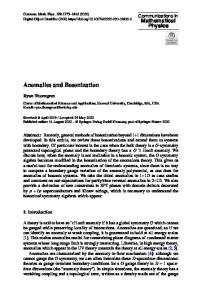Kohn Anomalies in Graphite and Nanotubes
- PDF / 116,054 Bytes
- 6 Pages / 595 x 842 pts (A4) Page_size
- 60 Downloads / 371 Views
HH7.4.1
Kohn Anomalies in Graphite and Nanotubes S. Piscanec1, M. Lazzeri2, A. C. Ferrari1, F. Mauri2, J. Robertson1 1
Cambridge University, Engineering Department, Cambridge, CB2 1PZ, UK Laboratoire de Mineralogie-Cristallographie de Paris, Université Pierre et Marie Curie, 75252, Paris, France 2
ABSTRACT Atomic vibrations are partially screened by electrons. In a metal this screening can change rapidly for vibrations associated to certain points of the Brillouin zone, entirely determined by the shape of the Fermi surface. The consequent anomalous behaviour of the phonon dispersion is called Kohn anomaly. Graphite is a semimetal. Nanotubes can be metals or semiconductors. We demonstrate that two Kohn anomalies are present in the phonon dispersion of graphite and that their slope is proportional to the square of the electron-phonon coupling. Metallic nanotubes have much stronger anomalies than graphite, due to their reduced dimensionality. Semiconducting nanotubes have no Kohn anomalies. INTRODUCTION The understanding of the physical mechanisms ruling the phonon dispersions and the electron-phonon coupling in graphite is a key step to derive the vibrational properties and the Raman intensities of carbon nanotubes. A key point to understand the phonons of graphite is the semi-metallic character of its electronic structure. In general, the atomic vibrations are partially screened by electronic states. In a metal this screening can change rapidly for vibrations associated to certain q points of the Brillouin zone, entirely determined by the shape of the Fermi surface. The consequent anomalous behavior of the phonon dispersion is called Kohn anomaly [1]. Here we show that Graphite displays two remarkable Kohn anomalies at the Γ-E2g and K-A’1 modes [2]. It is also a very remarkable case, since a very simple mathematical description of the Kohn anomalies is possible. Due to their reduced dimensionality, metallic tubes display much stronger Kohn anomalies than graphite. This results in phonon softening, implying that folded graphite cannot reproduce the phonon dispersions of metallic tubes. We perform ab-initio calculations using density functional perturbation theory within the general gradient approximation [2,3,4]. This allows the exact computation of phonon frequencies at any point of the Brillouin zone. The semi-metallic behavior of graphite is taken in account using fractional occupancy for the electronic states [5]. Calculations are done for both graphite and graphene. We use the experimental lattice parameters for graphite, aexp=2.46 Å, c=6.708 Å. For graphene we use both aexp and the calculated lattice parameter ath= 2.479 Å. Using periodic boundary conditions, graphene is calculated separating by 7.4 Å the single graphite layers. KOHN ANOMALIES IN GRAPHITE Kohn anomalies are anomalous features in the phonon dispersions of metals, due to a sudden change of the electronic screening of the ionic vibrations. Their occurrence is entirely determined by the geometry of the Fermi surface. In particular,
HH7.4.2
the
Data Loading...











